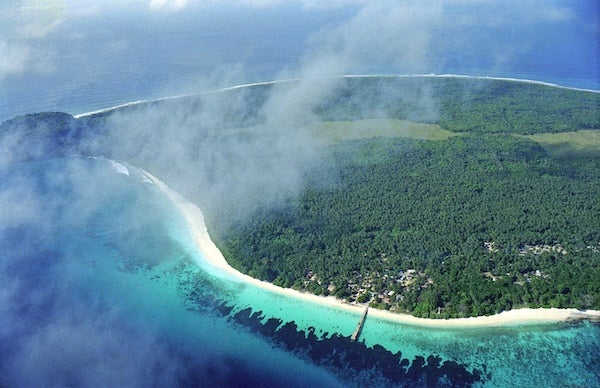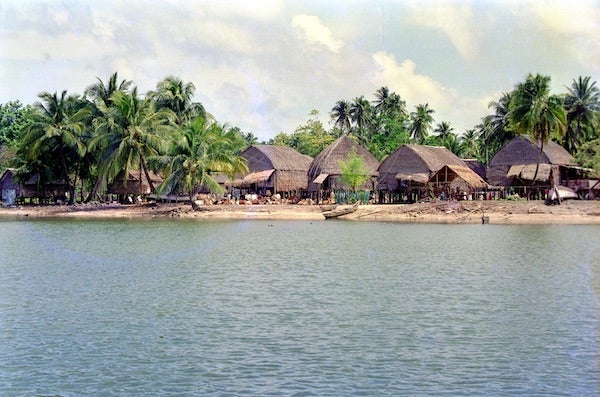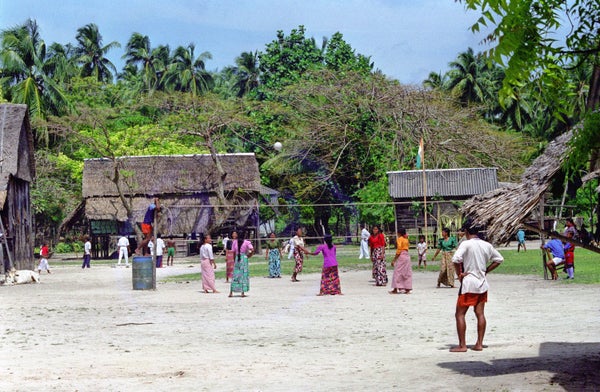Over a choppy phone call to the remote Nicobar archipelago, I told Indigenous leader Ayesha Majid that my friends in Delhi were dropping like flies. A horrific second wave of COVID-19 was ravaging India; crematoria were running out of wood and graveyards were running out of space. “Brother, how did this happen?” she asked in disbelief.
Earlier this year, COVID resurged in India with a vengeance. For a week in May, the country contributed over half of the daily COVID cases reported globally. COVID deaths in urban India are now abating, but people in rural India have been dying in droves.
Thus far in the second wave, however, the almost 24,000 Indigenous Nicobarese people, living on 11 tiny islands in the Bay of Bengal, have recorded not a single infection. The Nicobar archipelago is home to not only to these Indigenous peoples but also to more than 13,000 officials, defense personnel and settlers from mainland India. Early in the pandemic, they had thoughtlessly brought the virus to this remote outpost by traveling there from the adjacent Andaman archipelago.
On supporting science journalism
If you're enjoying this article, consider supporting our award-winning journalism by subscribing. By purchasing a subscription you are helping to ensure the future of impactful stories about the discoveries and ideas shaping our world today.
But despite initial panic, past trauma from a devastating earthquake and tsunami, illiteracy, poverty, lack of the most rudimentary facilities and remoteness from clinics and hospitals (seriously ill Nicobarese must usually travel to a hospital on the Andamans, a journey of up to 30 hours by sea) this remote community has managed to shield itself from the pandemic. Its experience shows that top-down policies that overlook regional and cultural values do more harm than good—whereas their bottom-up approach to self-protection carries important lessons for other vulnerable communities worldwide.

Chowra Island before the tsunami. Credit: Tilak Ranjan Bera
On March 24, 2020, the Indian prime minister ordered an abrupt 21-day coronavirus-induced nationwide lockdown, confining over 1.38 billion people to their homes. Overnight, millions of poor Indians—migrant workers, daily wage earners, smallholder farmers, the homeless and members of oppressed castes and tribes—found themselves in an extremely precarious situation. The lockdown was eventually extended in phases to 68 days. Among the world’s strictest, it precipitated a human tragedy, driving mass migrations and forcing 75 million people below the poverty line.
The day after the announcement, several Nicobarese leaders gathered nervously on Kamorta Island, a tiny dot of land in the vast eastern Indian Ocean. As Majid, who chairs one of the tribal councils, explained the situation, memories of a past trauma began to haunt the gathering. In December 2004, a deadly tsunami and the ensuing humanitarian aid had ravaged the Nicobarese society. Many Indigenous leaders began to fear that a similar calamity was again looming over their community.
In this remote tribal reserve, where concepts such as pandemics were utterly foreign, the abrupt lockdown engendered a novel crisis. When the local administration ordered the Nicobarese to not step out of their houses, many failed to understand why they were suddenly being restricted from fishing, hunting and tending to coconut plantations—activities essential to their survival. The police told them that a deadly virus was on the loose, indiscriminately claiming victims around the world; and that even the most advanced and resourceful governments had failed to suppress it. Social distancing, self-isolation and mask-wearing were the only protections against the virus, the Nicobarese learned. But such measures were alien to their worldview. The Indigenous peoples have a strong sense of community, living in large, multigenerational families and generously sharing resources.
Worse, traumatic memories of the tsunami resurfaced, paralyzing the Nicobarese and plunging them into a state of panic. In 2004, towering waves had devastated the Nicobars in the blink of an eye, extinguishing 3,449 lives by the official count (and 10,000, or roughly one third of the Nicobarese community as per the estimates of independent researchers). Those who survived were left so traumatized that they could not bear to look at the sea for months. The Nicobarese perceived COVID as a similar, imminent catastrophe. As memories of past trauma revived, their mental health took a hit. Many could not help worrying that the virus was lurking in their tropical forests, prowling on their beaches or secretly waiting to seize them outside their houses. The age of humans, some thought, had finally come to an end. Many believed they were certainly going to die.
At this critical juncture, Majid persuaded the village leaders of the central Nicobar Islands to mount a coherent COVID-19 response to support their reeling community. They relied on both tradition and science. They counseled the panic-gripped people, patiently addressed their endless queries and busted several myths. A group of women began to sew masks for distribution among the Nicobarese, as well as for the local civil and defense personnel. The tribal councils set up a dedicated quarantine facility, simplified and disseminated crucial coronavirus-related information in Nicobarese languages and appealed to the Indigenous peoples to practice self-regulated isolation, wash hands frequently andtake special care of the elderly. The councils also set up numerous temporary grocery shops in the villages to prevent risky trips to larger markets and deployed teams of volunteers to prohibit the movement of people in or out of the villages.

Trinket Village before the tsunami. Credit: Tilak Ranjan Bera
While the emotional support instantly boosted the community’s morale, the dissemination of scientific knowledge about the virus prepared the islanders to fend off contagion. After the tsunami, the traditional livelihoods of the Nicobarese had eroded, and many families now live precariously. The sudden lockdown worsened their predicament. Lifestyle changes since the tsunami have also brought in previously unknown ailments such as diabetes, making the Indigenous peoples even more vulnerable to serious illness should they get infected. So instead of adopting a one-size-fits-all approach, the tribal councils focused on the marginalized people and addressed their multilayered vulnerabilities. For instance, they prepared a list of needy families and supplied them with essential commodities. This assistance came as a lifeline to many; when the volunteers reached out to distant villages, they discovered that several households had no provisions left. “They had nothing to eat. Many could not contact anyone as they had no mobile phone or television to receive or exchange the information. They were so scared that they did not know what to do,” says Majid.
Coronavirus cases surged in India despite the lockdown, but thanks to the Nicobar’s remoteness, the Indigenes were temporarily safe in their villages. When travel restrictions to the Andaman and Nicobar Islands were relaxed in May 2020, however, thousands of residents who had been stuck in mainland India began to return, several of them carrying the virus. The tribal councils were alarmed: in a close-knit traditional society, where people live in multigenerational houses, a single case of coronavirus was potent enough to devastate the Indigenous community.
Over the past five centuries, alien germs and epidemics spread by European colonizers have exterminated scores of Indigenous societies around the world. The tragic fate of the neighboring Great Andamanese, whom imported epidemics had all but obliterated in the 19th century, reminded the Nicobarese leaders about their own unique vulnerabilities. Being a historically isolated community, the Nicobarese are highly susceptible to alien diseases, a vulnerability exacerbated by the inadequate public health system. Thus, maintenance of isolation—a natural protection that the Nicobarese enjoyed against the contagion—was crucial to their survival
The tribal councils began to lobby the local administration, pleading for restrictions on the movement of people to the Nicobars. Even so, the administration banned travel to the islands only after the coronavirus had infected people in northern and southern Nicobar Islands, which have significant populations of mainlanders. Fortunately, everyone survived and, with the infected people and their families diligently following COVID protocols, the disease did not spread. The tribal councils ensured that the Nicobarese watched over one another and immediately reported any symptoms of COVID to their leaders.
In this manner, the Nicobarese people managed to contain the spread of the first wave of the pandemic and seem to have escaped the second. Now that the Indian government has started a COVID-19 vaccination drive in the archipelago, the tribal leaders are again playing a crucial role in dispelling vaccine-related myths. Majid has led by example, encouraging her community to fearlessly get the injection.
The Nicobarese response offers some important lessons for effective management of the pandemic. The Indigenous peoples could successfully navigate through the crisis because their leaders acted promptly, collectively and selflessly; embraced the strengths of tradition and science; practiced democratic decision-making; created space for the community’s active involvement; emphasized accountability, integrity and transparency; ensured women’s equal participation; and prioritized the needs of vulnerable and marginalized people.
Throughout the world, the poor, vulnerable and marginalized sections of the society are being disproportionately affected by the pandemic. But a closer look also reveals that several Indigenous communities are engaged in spirited fight against the pandemic, using their community ties to effectively protect themselves. It is time we learned from the unique worldviews and equitable and inclusive responses of such Indigenous communities to the pandemic.
This is an opinion and analysis article; the views expressed by the author or authors are not necessarily those of Scientific American
